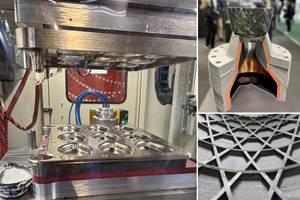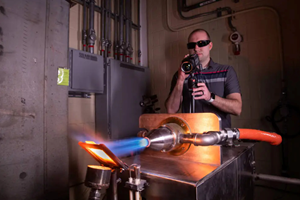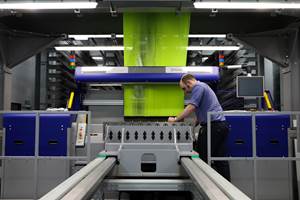GE Aviation to build ceramic matrix composite factories
One plant will be the first U.S.-based factory to produce SiC ceramic fiber on a large industrial scale.
GE Aviation (Cincinnati, OH) is creating adjacent factories in Huntsville, AL to mass-produce silicon carbide (SiC) materials used to manufacture ceramic matrix composite components (CMCs) for jet engines and land-based gas turbines. The company will invest more than $200 million to construct two factories on 100 acres in Huntsville. When the factories are operational later this decade, they are expected to employ up to 300 people.
One plant will produce silicon carbide (SiC) ceramic fiber and it will be the first such operation in the United States. Today, the only large-scale SiC ceramic fiber factory in the world is operated by NGS Advanced Fibers in Japan, which is a joint company of Nippon Carbon, GE, and Safran of France. The adjacent GE factory in Alabama will use the SiC ceramic fiber to produce the unidirectional CMC tape necessary to fabricate CMC components.
Construction of the two plants will begin in mid-2016, with full completion by the first half of 2018. Production is expected to begin in 2018.
Producing CMCs requires complex processing steps using a synthetically produced compound of silicon and carbon. The two GE Aviation factories being established are involved in separate steps in the process – the production of SiC ceramic fibers and the production of SiC ceramic tape.
The Ceramic Fiber Plant is supported by funding ($21.9 million) from the U.S. Air Force Research Lab Title III Office. This plant is expected to dramatically increase U.S. capability to produce SiC ceramic fiber capable of withstanding temperatures of 2400F.
The SiC ceramic fibers plant will license fiber-producing technology from NGS Advanced Fibers Co. in Japan, a joint company formed in 2012 with Japan’s Nippon Carbon (with 50% ownership in NGS), GE (25% ownership), and Herakles Safran France (25% ownership). NGS, which already produces SiC fibers for GE’s CMC components, is establishing a second factory in Japan to increase capacity to meet growing demand. The GE fiber plant in Huntsville will complement the growing capacity at NGS.
Once the Huntsville plant is operational, it will sell fiber to the Department of Defense, GE businesses, Herakles (Safran), and other outside customers subject to U.S. regulations. The two other NGS partners will ultimately have the opportunity to become equity partners in the Huntsville plant.
The CMC Tape Operation will be an adjacent plant, financed solely by GE, and will apply proprietary coatings to the ceramic fiber and form them into a matrix to produce CMC tape. The ceramic tape will be used by GE Aviation at its new CMC manufacturing site in Asheville, N.C., which opened in 2014. The Asheville facility fabricates CMC shrouds for the LEAP engine’s high-pressure turbine section.
In addition, GE’s Power and Water business is testing CMCs in its newest and most efficient, air-cooled gas turbine. At GE Power and Water’s new Advanced Manufacturing Works facility in Greenville, SC, prototype CMC components are being built to replace super alloys in large gas turbines.
For more than 20 years, scientists at GE’s Global Research Centers and GE’s industrial businesses have worked to develop CMCs for commercial applications. The LEAP engine, being developed by CFM International, the 50/50 joint company of GE and Snecma (Safran) of France, is the first commercial jet engine to use CMCs in the high-pressure turbine section. The LEAP engine, with more than 9,500 orders and commitments, is currently completing certification testing. It is scheduled to enter airline service next year powering the Airbus A320neo, and in 2017 powering the Boeing 737 MAX.
The demand for CMCs is expected to grow tenfold over the next decade. Each LEAP has 18 CMC turbine shrouds, which are stationary parts in the high-pressure turbine that direct air and ensure turbine blade efficiency. Also, CMCs are being used in the combustor and high-pressure turbine section of the new GE9X engine under development for the Boeing 777X twin-aisle aircraft. Almost 700 GE9X engines are on order today, with the aircraft entering service by 2020.
GE is incorporating CMC components in advanced military engines including the GE3000 for the U.S. Army. GE’s advanced turboshaft demonstrator FATE (Future Affordable Turbine Engine) also for the Army increases the use of hot-section CMCs to achieve aggressive fuel efficiency, power-to-weight ratio, and lower maintenance cost goals. CMCs are currently being evaluated for upgrades to existing engines like the T700 helicopter engine.
“Establishing the new GE factories in Alabama is a very significant step in developing the supply chain we need in order to produce CMC components in large volume,” said Sanjay Correa, vice president of the CMC program at GE Aviation.
Related Content
Lockheed Martin expands development, production of ultra-high temp CMCs with facility expansion
Targeting current and future needs in hypersonic and aeronautics applications, Lockheed Martin Skunk Works’ Allcomp team is increasing and digitizing its capabilities in ceramic matrix composite (CMC) materials and parts fabrication.
Read MoreJEC World 2024 highlights: Thermoplastic composites, CMC and novel processes
CW senior technical editor Ginger Gardiner discusses some of the developments and demonstrators shown at the industry’s largest composites exhibition and conference.
Read MoreGE Aerospace awarded demonstration contract for NASA HyTEC project
Turbofan engine small core technology development with CMC-coated components targets enhanced fuel efficiency in single-aisle aircraft by mid-2030s.
Read MoreAMRC fiber handling expertise aids CMC coating technology
The CICSiC project successfully developed equipment and processing know-how associated with the uniform, continuous coating of SiC-based CMC, to bring down cost, and improve performance and reliability for new designs, applications.
Read MoreRead Next
From the CW Archives: The tale of the thermoplastic cryotank
In 2006, guest columnist Bob Hartunian related the story of his efforts two decades prior, while at McDonnell Douglas, to develop a thermoplastic composite crytank for hydrogen storage. He learned a lot of lessons.
Read MoreCW’s 2024 Top Shops survey offers new approach to benchmarking
Respondents that complete the survey by April 30, 2024, have the chance to be recognized as an honoree.
Read MoreComposites end markets: Energy (2024)
Composites are used widely in oil/gas, wind and other renewable energy applications. Despite market challenges, growth potential and innovation for composites continue.
Read More

























